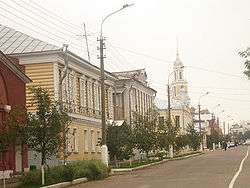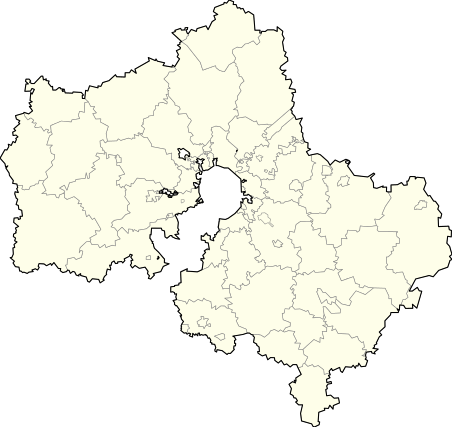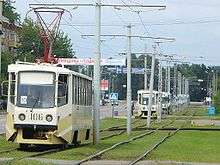Kolomna
| Kolomna (English) Коломна (Russian) | |
|---|---|
| - City[1] - | |
 Historic center of Kolomna | |
.svg.png) Location of Moscow Oblast in Russia | |
 Kolomna | |
|
| |
.png) |
|
|
| |
| Administrative status (as of January 2013) | |
| Country | Russia |
| Federal subject | Moscow Oblast[1] |
| Administratively subordinated to | Kolomna City Under Oblast Jurisdiction[1] |
| Administrative center of | Kolomensky District,[1] Kolomna City Under Oblast Jurisdiction[1] |
| Municipal status (as of May 2010) | |
| Urban okrug | Kolomna Urban Okrug[2] |
| Administrative center of | Kolomna Urban Okrug,[3] Kolomensky Municipal District[2] |
| Head | Valery Shuvalov |
| Representative body | Council of Deputies |
| Statistics | |
| Area (urban okrug) (May 2010) | 67.12 km2 (25.92 sq mi)[2] |
| Population (2010 Census) | 144,589 inhabitants[4] |
| - Rank in 2010 | 119th |
| Density | 2,154/km2 (5,580/sq mi)[5] |
| Time zone | MSK (UTC+03:00)[6] |
| Founded | 1177 |
| Postal code(s)[7] | 140400 |
| Dialing code(s) | +7 496 |
|
| |
| Kolomna on Wikimedia Commons | |

Kolomna (Russian: Колóмна; IPA: [kɐˈlomnə]) is an ancient city of Moscow Oblast, Russia, situated at the confluence of the Moskva and Oka Rivers, 114 kilometers (71 mi) (by rail) southeast of Moscow. Population: 144,589 (2010 Census);[4] 150,129 (2002 Census);[8] 161,881 (1989 Census).[9]
History
Mentioned for the first time in 1177, Kolomna was founded in 1140–1160 according to the latest archaeological surveys.[10] Kolomna's name may originate from the Old Russian term for "on the bend (in the river)", especially as the old city is located on a sharp bend in the Moscow River. In 1301, Kolomna was incorporated into the Moscow Principality.[11]
Like some other ancient Russian cities, it has a kremlin, which is a citadel similar to the more famous one in Moscow and also built of red brick.[12] The stone Kolomna Kremlin was built from 1525–1531 under the Russian Tsar Vasily III. The Kolomna citadel was a part of the Great Abatis Border[13] and, although much of the surrounding wall was removed in the eighteenth century and materials used to construct other public buildings, the remaining stretch of wall, several towers, and some interior buildings have been preserved and held in a good shape. A museum is located inside. In front of the façade stands a statue of Dmitry Donskoy, celebrating the gathering of his troops in Kolomna prior to the Battle of Kulikovo in 1380.
The civic arms of Kolomna were granted by Empress Catherine II, who was influenced by the similar-sounding name of the famous Colonna family of Rome. Hence, the similar appearance of the arms, despite there being no connection between the Roman family and the city of Kolomna.
Due to sensitive military production of missile components, Kolomna was a closed city until 1994. It is still not listed as a city of the Golden Ring, despite its kremlin and the large number of well-preserved churches and monasteries.

Administrative and municipal status
Within the framework of administrative divisions, Kolomna serves as the administrative center of Kolomensky District, even though it is not a part of it.[1] As an administrative division, it is incorporated separately as Kolomna City Under Oblast Jurisdiction—an administrative unit with the status equal to that of the districts.[1] As a municipal division, Kolomna City Under Oblast Jurisdiction is incorporated as Kolomna Urban Okrug.[2]
Transportation

Rail
Kolomna is located on the Ryazan line of the Moscow railroad, 116 kilometers (72 mi) from Moscow. In Kolomna, there are five railway stations (Kolomna, Shchurovo, Bochmanovo, 6 km, and Sychevo) and one terminal (Golutvin).
Public transportation
Two bus terminals are located in the city. Public transport in the city is represented by tram and city bus lines.
 LiAZ-6212 articulated bus
LiAZ-6212 articulated bus KTM-23 low-entry tram
KTM-23 low-entry tram Golutvin railway station
Golutvin railway station
Water
Kolomna is situated on three rivers, and has passenger and transport berths. Most known one is the Bochmanovo (Russian: Бочманово) berth.
Sports
The Kolomna Speed Skating Center is an indoor ice speed skating oval used for Russian and international championships. It hosted the 2008 European Allround Speed Skating Championships and the 2016 World Single Distance Speed Skating Championships. The Kolomna Speed Skating Center is considered as one of the most modern ice speed skating ovals in the world.
Demographics
| Year | 1897 | 1926 | 1939 | 1959 | 1962 | 1967 | 1970 | 1973 | 1976 | 1979 |
|---|---|---|---|---|---|---|---|---|---|---|
| Рopulation | 20.9 | 35 | 85 | 118 | 125 | 131 | 136 | 140 | 145 | 146.5 |
| Year | 1982 | 1986 | 1989 | 1992 | 1996 | 1998 | 2000 | 2001 | 2003 | 2006 |
| Рopulation | 151 | 158 | 162 | 163.7 | 153.6 | 152.1 | 150.7 | 149.6 | 150.1 | 148.0 |
Notable people
- Filaret, Metropolitan of Moscow
- Dmitry Dorofeyev, speed skater
- Nikolay Epshtein (born 1918), Soviet ice hockey coach
- Sergey Gorshkov, Soviet admiral
- Mikhail Katukov, commander of armored troops in the Red Army
- Yekaterina Lobysheva, speed skater
- Eduard Malofeyev, football player and manager
- Mikhail Tyurin, cosmonaut
- Edward Frenkel, mathematician
- Olga Graf, speed skater
- Sergey Malitsky, fantasy fiction writer
- Vitalik Buterin, programmer and writer and inventor of Ethereum
Attractions

- Bobrenev cloister
- Staro-Golutvin cloister
- Novo-Golutvin cloister
- Posad, with several churches
- Church of John the Baptist, one of only three 14th-century buildings preserved in Moscow Oblast.
- Museum of pastila, a locally produced fruit candy
- Kolomna Speed Skating Center
- Museum of Organic Culture
International relations
Twin towns and sister cities
Kolomna is twinned with:
 Maladzyechna, Belarus
Maladzyechna, Belarus Bauska, Latvia
Bauska, Latvia Moscow, Russia
Moscow, Russia
References
Notes
- 1 2 3 4 5 6 7 Law #11/2013-OZ
- 1 2 3 4 Law #153/2004-OZ
- ↑ Law #43/2005-OZ
- 1 2 Russian Federal State Statistics Service (2011). "Всероссийская перепись населения 2010 года. Том 1" [2010 All-Russian Population Census, vol. 1]. Всероссийская перепись населения 2010 года (2010 All-Russia Population Census) (in Russian). Federal State Statistics Service. Retrieved June 29, 2012.
- ↑ The value of density was calculated automatically by dividing the 2010 Census population by the area specified in the infobox. Please note that this value may not be accurate as the area specified in the infobox does not necessarily correspond to the area of the entity proper or is reported for the same year as the population.
- ↑ Правительство Российской Федерации. Федеральный закон №107-ФЗ от 3 июня 2011 г. «Об исчислении времени», в ред. Федерального закона №271-ФЗ от 03 июля 2016 г. «О внесении изменений в Федеральный закон "Об исчислении времени"». Вступил в силу по истечении шестидесяти дней после дня официального опубликования (6 августа 2011 г.). Опубликован: "Российская газета", №120, 6 июня 2011 г. (Government of the Russian Federation. Federal Law #107-FZ of June 31, 2011 On Calculating Time, as amended by the Federal Law #271-FZ of July 03, 2016 On Amending Federal Law "On Calculating Time". Effective as of after sixty days following the day of the official publication.).
- ↑ Почта России. Информационно-вычислительный центр ОАСУ РПО. (Russian Post). Поиск объектов почтовой связи (Postal Objects Search) (Russian)
- ↑ Russian Federal State Statistics Service (May 21, 2004). "Численность населения России, субъектов Российской Федерации в составе федеральных округов, районов, городских поселений, сельских населённых пунктов – районных центров и сельских населённых пунктов с населением 3 тысячи и более человек" [Population of Russia, Its Federal Districts, Federal Subjects, Districts, Urban Localities, Rural Localities—Administrative Centers, and Rural Localities with Population of Over 3,000] (XLS). Всероссийская перепись населения 2002 года [All-Russia Population Census of 2002] (in Russian). Retrieved August 9, 2014.
- ↑ Demoscope Weekly (1989). "Всесоюзная перепись населения 1989 г. Численность наличного населения союзных и автономных республик, автономных областей и округов, краёв, областей, районов, городских поселений и сёл-райцентров" [All Union Population Census of 1989: Present Population of Union and Autonomous Republics, Autonomous Oblasts and Okrugs, Krais, Oblasts, Districts, Urban Settlements, and Villages Serving as District Administrative Centers]. Всесоюзная перепись населения 1989 года [All-Union Population Census of 1989] (in Russian). Институт демографии Национального исследовательского университета: Высшая школа экономики [Institute of Demography at the National Research University: Higher School of Economics]. Retrieved August 9, 2014.
- ↑ (Russian) Мазуров А. Б. Средневековая Коломна в XIV — первой трети XVI вв. / Под ред. В. Л. Янина. М.: Александрия, 2001. С. 58
- ↑ Nossov K. S. Medieval Russian Fortresses AD 862-1480. Osprey Publishing. 2012. P. 8
- ↑ Brumfield W. C. Landmarks of Russian Architecture: A Photographic Survey. Routledge. Pp. 94-95
- ↑ Several towers and two parts of walls
Sources
- Московская областная Дума. Закон №11/2013-ОЗ от 31 января 2013 г. «Об административно-территориальном устройстве Московской области», в ред. Закона №72/2015-ОЗ от 5 мая 2015 г. «Об отнесении города Озёры Озёрского района Московской области к категории города областного подчинения Московской области, упразднении Озёрского района Московской области и внесении изменений в Закон Московской области "Об административно-территориальном устройстве Московской области"». Вступил в силу на следующий день после официального опубликования (13 января 2013 г.). Опубликован: "Ежедневные Новости. Подмосковье", №24, 12 февраля 2013 г. (Moscow Oblast Duma. Law #11/2013-OZ of January 31, 2013 On the Administrative-Territorial Structure of Moscow Oblast, as amended by the Law #72/2015-OZ of May 5, 2015 On Re-Classifying the Town of Ozyory in Ozyorsky District of Moscow Oblast as the Town Under Oblast Jurisdiction, on Abolishing Ozyorsky District of Moscow Oblast, and on Amending the Law of Moscow Oblast "On the Administrative-Territorial Structure of Moscow Oblast". Effective as of the day following the day of the official publication (January 13, 2013).).
- Московская областная Дума. Закон №153/2004-ОЗ от 25 ноября 2004 г. «О статусе и границе городского округа Коломна», в ред. Закона №52/2010-ОЗ от 6 мая 2010 г «О внесении изменений в Закон Московской области "О статусе и границе городского округа Коломна" и Закон Московской области "О статусе и границах Коломенского муниципального района и вновь образованных в его составе муниципальных образований"». Вступил в силу со дня официального опубликования. Опубликован: "Ежедневные Новости. Подмосковье", №231, 4 декабря 2004 г. (Moscow Oblast Duma. Law #153/2004-OZ of November 25, 2004 On the Status and the Border of Kolomna Urban Okrug, as amended by the Law #52/2010-OZ of May 6, 2010 On Amending the Law of Moscow Oblast "On the Status and the Border of Kolomna Urban Okrug" and the Law of Moscow Oblast "On the Status and Borders of Kolomensky Municipal District and the Newly Established Municipal Formations It Comprises". Effective as of the day of the official publication.).
- Московская областная Дума. Закон №43/2005-ОЗ от 15 февраля 2005 г. «О статусе и границах Коломенского муниципального района и вновь образованных в его составе муниципальных образований», в ред. Закона №121/2011-ОЗ от 14 июля 2011 г. «О внесении изменений в Закон Московской области "О статусе и границах Коломенского муниципального района и вновь образованных в его составе муниципальных образований"». Вступил в силу со дня официального опубликования. Опубликован: "Ежедневные Новости. Подмосковье", №35, 26 февраля 2005 г. (Moscow Oblast Duma. Law #43/2005-OZ of February 15, 2005 On the Status and the Borders of Kolomensky Municipal District and the Newly Established Municipal Formations Comprising It, as amended by the Law #121/2011-OZ of July 14, 2011 On Amending the Law of Moscow Oblast "On the Status and the Borders of Kolomensky Municipal District and the Newly Established Municipal Formations Comprising It". Effective as of the day of the official publication.).
 "Kolomna". Encyclopædia Britannica. 15 (11th ed.). 1911.
"Kolomna". Encyclopædia Britannica. 15 (11th ed.). 1911.
